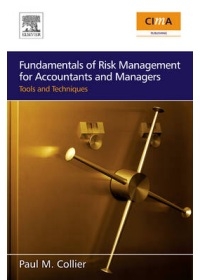- 定價200.00元
-
8
折優惠:HK$160

|
|
|
|
Fundamentals of Risk Management for Accountants and Managers: Tools and Techniques
|

|

沒有庫存
訂購需時10-14天
|
|
|
|

|
|
9780750686501 | |
|

|
|
Paul M. Collier | |
|

|
|
新陸書局 | |
|

|
|
2009年6月01日
| |
|

|
|
367.00 元
| |
|

|
|
HK$ 330.3
|
|
|
|
|

| |
|
|
|
|
| |
|
|
詳
細
資
料
|
* 叢書系列:Accounting
* 規格:平裝 / 普級 / 單色印刷 / 初版
* 出版地:台灣
Accounting
|
|
分
類
|
商業理財 > 專業管理實務 > 財務管理 |
同
類
書
推
薦
|
|
|
內
容
簡
介
|
Description
Both financial and non-financial managers with accountability for performance at either a strategic level or for a business unit have responsibility for risk management, in terms of failing to achieve organisational objectives. Fundamentals of Enterprise Risk management is structured around four parts and 26 self-contained chapters. Each chapter will have ample practical examples and illustrations/mini-case studies from retail, manufacturing and service industries and from the public and not-for-profit sectors to enable the reader to understand and apply the concepts in the book.
Paul M. Collier, Senior Lecturer, Management Accounting, Department of Accounting and Finance, Monash University in Melbourne, Australia
|
|
目
錄
|
Part A: Introducing risk management
1.The emergence of risk The origins of the risk discipline in OH&S, insurance, project management and financial derivatives. Influence of key writers such as Beck and Adams.
2.The corporate governance agenda The influence of Cadbury, corporate failures at Enron and WorldCom, Sarbanes-Oxley, the King Report, audit and risk committees.
3.Corporate governance and risk management in the public and not-for-profit sectors
Part B: A strategic perspective on Enterprise Risk Management
4.Towards Enterprise Risk Management (ERM) The traditional approach to risk management compared with ERM. Various models of risk management, e.g. COSO (US), the IRM (UK), the Australian risk standard, Basel, etc.
5.Risk and strategy: product/markets, supply chain, competitive position, brands, regulation, technology change, reputation, distribution channels. Risk and sustainable competitive advantage.
6.Risk categorisation Types of risk and the advantages of categorisation
7.Techniques for identifying and assessing risks Likelihood/consequences. Risk registers. Risk reviews.
8.The manager?s role in risk management Role of the risk manager. Risk management groups. Risk management software. Risk management policy
9.Risk and culture Risk appetite. National, organisational and professional cultures. Embedding risk into the organisation.
Part C: Risk applications in the organisation
10.Risk and financial reporting Reporting to shareholders, divisional performance measurement
11.Risk and financial decision making Budgeting, profitability analysis, capital investment
12.Risk and information systems Systems design, development and implementation. The IT environment and different applications. Networks. IT controls
13.Risk in financial services Derivatives, Interest rates, Foreign exchange
14.Health and safety risk management Risk assessments. Risk auditing. Risk recording
15.Credit risk management Credit approval. Credit management. Credit financing.
16.Asset risk management Supply chain risks. Purchasing risk. Breakdown risk. Obsolescence risk.
17.Project risk management and contract risk Legal and commercial risk. Negotiating and managing contracts and projects. Technical and contractual delivery.
18.Risk and fraud Preventing, identifying and responding to fraud
19.Risk and the environment Pollution, contamination, sustainability and global warming. ISO14000
20.Risk and crisis management From 9/11 to business continuity
21.Risk and insurance Principles of insurance. Liability. Property. Self insurance. Reinsurance. Part D: Evaluating risk management
22.Risk, the audit committee and the risk committee
23.Risk and internal control
24.Risk and internal audit
25.Auditing risk management
26.The future of risk management Glossary of terms Index
|
|
|
書
評
|
|
|
|
|

